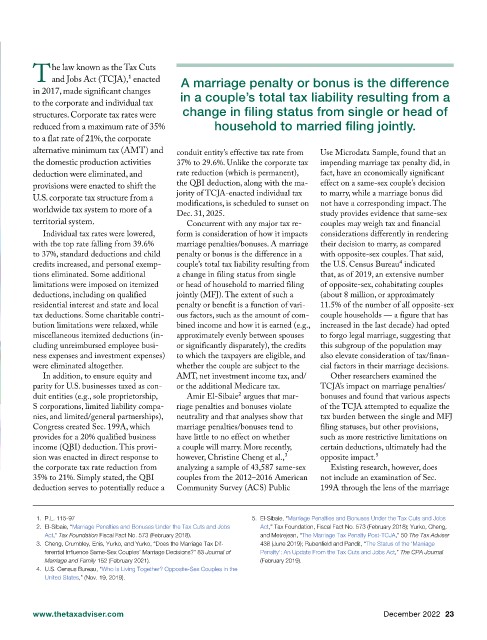Page 632 - TaxAdviser_2022
P. 632
he law known as the Tax Cuts
A marriage penalty or bonus is the difference
Tand Jobs Act (TCJA),¹ enacted
in 2017, made significant changes in a couple’s total tax liability resulting from a
to the corporate and individual tax
structures. Corporate tax rates were change in filing status from single or head of
household to married filing jointly.
reduced from a maximum rate of 35%
to a flat rate of 21%, the corporate
alternative minimum tax (AMT) and conduit entity’s effective tax rate from Use Microdata Sample, found that an
the domestic production activities 37% to 29.6%. Unlike the corporate tax impending marriage tax penalty did, in
deduction were eliminated, and rate reduction (which is permanent), fact, have an economically significant
the QBI deduction, along with the ma- effect on a same-sex couple’s decision
provisions were enacted to shift the
jority of TCJA-enacted individual tax to marry, while a marriage bonus did
U.S. corporate tax structure from a
modifications, is scheduled to sunset on not have a corresponding impact. The
worldwide tax system to more of a
Dec. 31, 2025. study provides evidence that same-sex
territorial system. Concurrent with any major tax re- couples may weigh tax and financial
Individual tax rates were lowered, form is consideration of how it impacts considerations differently in rendering
with the top rate falling from 39.6% marriage penalties/bonuses. A marriage their decision to marry, as compared
to 37%, standard deductions and child penalty or bonus is the difference in a with opposite-sex couples. That said,
credits increased, and personal exemp- couple’s total tax liability resulting from the U.S. Census Bureau⁴ indicated
tions eliminated. Some additional a change in filing status from single that, as of 2019, an extensive number
limitations were imposed on itemized or head of household to married filing of opposite-sex, cohabitating couples
deductions, including on qualified jointly (MFJ). The extent of such a (about 8 million, or approximately
residential interest and state and local penalty or benefit is a function of vari- 11.5% of the number of all opposite-sex
tax deductions. Some charitable contri- ous factors, such as the amount of com- couple households — a figure that has
bution limitations were relaxed, while bined income and how it is earned (e.g., increased in the last decade) had opted
miscellaneous itemized deductions (in- approximately evenly between spouses to forgo legal marriage, suggesting that
cluding unreimbursed employee busi- or significantly disparately), the credits this subgroup of the population may
ness expenses and investment expenses) to which the taxpayers are eligible, and also elevate consideration of tax/finan-
were eliminated altogether. whether the couple are subject to the cial factors in their marriage decisions.
In addition, to ensure equity and AMT, net investment income tax, and/ Other researchers examined the
parity for U.S. businesses taxed as con- or the additional Medicare tax. TCJA’s impact on marriage penalties/
duit entities (e.g., sole proprietorship, Amir El-Sibaie² argues that mar- bonuses and found that various aspects
S corporations, limited liability compa- riage penalties and bonuses violate of the TCJA attempted to equalize the
nies, and limited/general partnerships), neutrality and that analyses show that tax burden between the single and MFJ
Congress created Sec. 199A, which marriage penalties/bonuses tend to filing statuses, but other provisions,
provides for a 20% qualified business have little to no effect on whether such as more restrictive limitations on
income (QBI) deduction. This provi- a couple will marry. More recently, certain deductions, ultimately had the
sion was enacted in direct response to however, Christine Cheng et al.,³ opposite impact.⁵
the corporate tax rate reduction from analyzing a sample of 43,587 same-sex Existing research, however, does
35% to 21%. Simply stated, the QBI couples from the 2012–2016 American not include an examination of Sec.
deduction serves to potentially reduce a Community Survey (ACS) Public 199A through the lens of the marriage
1. P.L. 115-97 5. El-Sibaie, “Marriage Penalties and Bonuses Under the Tax Cuts and Jobs
2. El-Sibaie, “Marriage Penalties and Bonuses Under the Tax Cuts and Jobs Act,” Tax Foundation, Fiscal Fact No. 573 (February 2018); Yurko, Cheng,
Act,” Tax Foundation Fiscal Fact No. 573 (February 2018). and Metrejean, “The Marriage Tax Penalty Post-TCJA,” 50 The Tax Adviser
3. Cheng, Crumbley, Enis, Yurko, and Yurko, “Does the Marriage Tax Dif- 438 (June 2019); Rubenfield and Pandit, “The Status of the ‘Marriage
ferential Influence Same-Sex Couples’ Marriage Decisions?” 83 Journal of Penalty’: An Update From the Tax Cuts and Jobs Act,” The CPA Journal
Marriage and Family 152 (February 2021). (February 2019).
4. U.S. Census Bureau, “Who Is Living Together? Opposite-Sex Couples in the
United States,” (Nov. 19, 2019).
www.thetaxadviser.com December 2022 23

